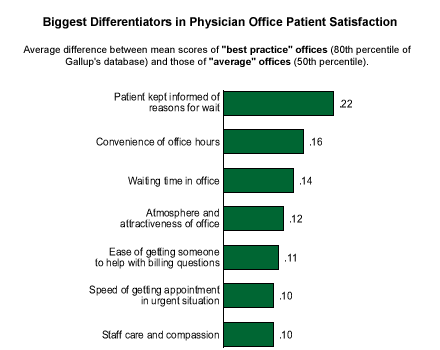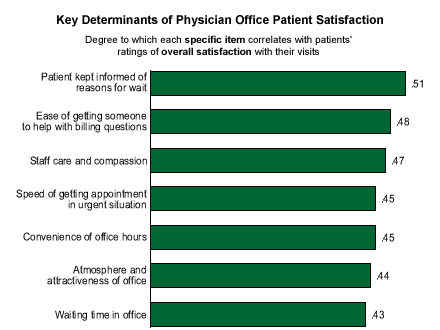Nearly everyone visits a physician's office at some point each year -- in November 2004, 90% of Americans reported seeing the doctor at least once in the last 12 months. While it may rarely be an enjoyable experience, some patients probably mind the trip far less than others do. What makes a good physician office experience different from a mediocre one?
Gallup's healthcare database offers some answers. We measure patient satisfaction with several different aspects of the physician office experience. The question items with the largest variation between the "average" score (those at the 50th percentile of the Gallup database) and the "best practice" score (those at the 80th percentile) are the items that best differentiate a good experience from one that patients feel could have been better. Of the seven question items that have a difference of .10 or more between the two scores, "patient kept informed of reasons for wait" has the highest variation.

Many of the items that best differentiate good and bad doctor's office experiences are the same as those that best differentiate good and bad hospital emergency department experiences. Though the environments are different, most patients' primary goal in both is to see a physician or healthcare provider as quickly as possible, often for an episodic health concern. Four of the seven top differentiators ("patient kept informed of reasons for wait," "convenience of office hours," "waiting time in office," and "speed of getting an appointment in urgent situation") relate to speed of service and convenience.
What Drives Patient Satisfaction in the Physician's Office?
When trying to improve satisfaction with a physician's office, it's not enough to know what differentiates average experiences from great ones. It's also important to know which items are most important to patients' overall satisfaction. That is, which items correlate most highly to patients' overall assessments of their visit?

"Patient kept informed of reasons for wait time" has both the highest correlation to overall physician office satisfaction and the largest variance between average and best practice scores. Communicating with patients about wait time and making an effort to express awareness that their time is valuable is a key to giving patients a positive impression of their office visit.
What's more, keeping the patient informed about wait time is more important than the actual length of the wait itself. I recently had a physician office experience that illustrates why: After checking in with the registration staff, I settled into the waiting area with a book, anticipating a lengthy wait. Sometime later, a registration person approached me and said that because I had waited more than 15 minutes (their performance standard), I was entitled to $10 off my next visit. The wait hadn't seemed unreasonable -- nevertheless, the communication and compensation gave me a memorably positive impression of my experience.
Bottom Line
Things never go perfectly in any aspect of life, physician office visits included. But when staff members work quickly to solve problems (such as explaining wait time or giving timely assistance on billing questions), patients will notice and be more satisfied as a result.